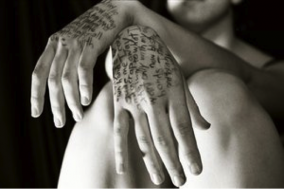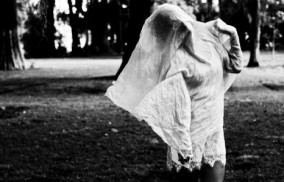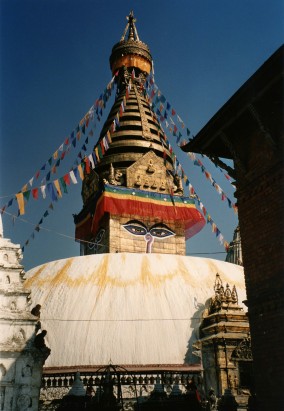Our bodies conceptualize not only themselves but also each other, murmuring:
Yes, you are there; yes, you are you; yes, you can love and be loved.
–Nancy Mairs, from “Body in Trouble” (2011)
What is Body Narrative?
Body narrative is simply writing the story of our bodies. In this type of writing, we blur the mind/body boundary through an activity that is typically more closely associated with the mind. As author Nancy Mairs writes, “Even if one has lived within a mind cut off from the body, the body has been there all along.”[i]
Body narratives encompass our mental, emotional, physical and spiritual power. They allow us to integrate body awareness, sensations, and movement into our writing and help us connect with our bodies as we write. They allow us to get in touch with ourselves.
Body narrative can be a powerful catalyst for self-discovery. Writing the intangible and the invisible—the internal experience of the body–heightens our awareness of body sensations and emotions, provides insight and understanding, helps translate experience into language, and facilitates connection and healing. In the process of writing a body narrative, we may begin to accept our bodies and understand how our bodies hold our stories.
Imagine what it would feel like to accept your body, and stop viewing yourself through an out-of-focus lens. Take for example, Walt Whitman’s “I Sing the Body Electric,” a poem that celebrates and glorifies the body in all its manifestations, whether stretched, flabby, or swollen:
The love of the Body of man or woman balks account—the body itself balks account;
That of the male is perfect, and that of the female is perfect.
In writing our body narrative we can develop the sense that our bodies belong to us, and come to terms with our oftentimes fragmented existence. Through “writing the body,” we can move from living in the shadows to accepting ourselves.
To write as if your life depended on it; to write across the chalkboard,
putting up there in public the words you have dredged;
sieved up in dreams, from behind screen memories, out of silence–
words you have dreaded and needed in order to know you exist.
-Adrienne Rich
The doing of writing about and through the body helps us make meaning of what dwells within our bodies and helps us access our innate wisdom, which is often lost in daily life.
In one of her personal essays in Voice Lessons, Mairs writes, “Fortunately one cannot be without being a body. One simply is blood, thud of heart, lick of tongue, brain humped and folded into skull. And it is a body that one inhabits the past and it inhabits one’s body.”[ii]
Why Write Body Narrative?
We write body narrative to unearth our perceptions, judgments, and beliefs about our body, to increase awareness and esteem, release tension, unleash restricted physical, intellectual, and emotional movement, and celebrate our uniqueness and self-hood. Body narrative also allows us to explore our identity, sexuality, and ideals.
Here in this body are the sacred rivers: here are the sun and moon, as well as the pilgrimage places.
I have not encountered another temple as blissful as my own body. -Saraha Doha, Indian Mystic
The process of consciously entering into conversation with your body, exploring body story, can enable deep and direct connection with issues that most need expression. The goal is exploration and reclaiming voice through the construction of reflective and insightful body narrative. Narratives written from the body can help improve our writing. Even if you’re a highly skilled writer, your writing can still benefit from body narrative.
How to Get Started Writing Body Narrative
Professor, poet, literary critic Hélène Cixous wrote, “Writing is writing what you cannot know before you have written.”[iii] To get started, try exploring even the most basic questions about physical experiences. For example,
- What do I think of my body?
- What I like about my body most is…
- My body was…
- I was capable of…
To go deeper into the experience of the body, write from the following prompts.
- I believed…
- My body has a story to tell and this is the story…
- What my body needs from me is…
Our body can also provide us an opportunity for reflection. British novelist and essayist, Nicola A. Griffith writes about life before multiple sclerosis,
I have always enjoyed my body. I grew up using and pleasuring it hard. I played tennis, did gymnastics, competed on the track. I worked as a laborer with pickaxe, shovel and wheelbarrow at an archaeological dig. I dug trenches and planted trees for the city council. I studied karate and taught women’s self defense. I had three lovers as well as my live-in partner. Drank whiskey, ate magic mushrooms, took a lot of speed, sang in a band half the night, went home with one woman or another and cycled to work at dawn after no sleep. I was invulnerable, unconquerable (probably insufferable). The fiction I wrote was physical: explosions, travel through space and time, fantasy figures rescuing fairy tale characters, and so on.[iv]
For people who have suffered physical or emotional trauma, please note that writing about painful or shameful issues is inherently risky. One can never be sure whether such writing or reading will lead to re-traumatization or recovery. Write with care, and take breaks as needed.
Exercise:
Look at pictures of yourself at different ages and stages. Look at the change in yourself over time. What do you see that you didn’t see before? Can you remember what you felt at the time the photograph was taken? How do you feel now looking at it? Have some characteristics stayed the same over the years? What has changed or shifted? How has “life” changed you?
Study these pictures of yourself and answer the following prompts.
Before today I never thought about________. I believed I understood_____________, but now I’m considering ________.
Thinking deeply is how we grow. And writing your thoughts commits you to examining them more fully than you can in internal monologue, or even in spoken conversation with others.
Future columns will discuss specific issues and writing techniques used in body narrative.
Sources
[i] Rainer, T. (1998). Your Life as Story. New York, New York: Tarcher Publishing. p. 202.
[ii] Mairs, N. (1997). Voice Lessons. Beacon Press.
[iii] Cixous, H. (1994). Three Steps on the Ladder of Writing, New York, New York: Columbia University Press, p. 65.
[iv] Griffith, N. (n.d.). “Writing from the Body.” Retrieved December 9, 2013 from http://nicolagriffith.com/body.html. Permission provided via email.
Debbie spent 30 years as a registered nurse. She became a certified applied poetry facilitator and journal-writing instructor in 2007. She is currently a student in the Johns Hopkins Science-Medical Writing program. Her publications have appeared in Journal of Poetry Therapy, Studies in Writing: Research on Writing Approaches in Mental Health, Women on Poetry: Tips on Writing, Teaching and Publishing by Successful Women, Statement CLAS Journal, The Journal of the Colorado Language Arts Society, and Red Earth Review.



 Ashley Inguanta
Ashley Inguanta
 On Thursday, my family and I will (thankfully) have a festive Nepali meal. We’ll gather around my parents’ 1980s country style dining table with its white legs and blond wood top. There will be an awfully white, bright light above us spotlighting our non-traditional meal. And seven people will be squeezing in around the table, making the best of an American holiday.
On Thursday, my family and I will (thankfully) have a festive Nepali meal. We’ll gather around my parents’ 1980s country style dining table with its white legs and blond wood top. There will be an awfully white, bright light above us spotlighting our non-traditional meal. And seven people will be squeezing in around the table, making the best of an American holiday.